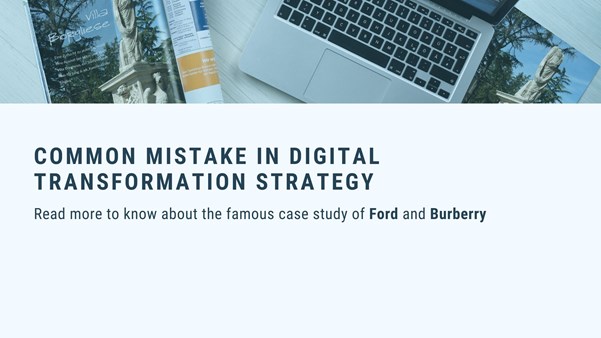
Digital Transformation: Decoding 3-common transformation strategy mistakes
Are you doing a bunch of research about digital transformation before jumping into it?
‘Digital transformation’, a concept that is no longer brand new, especially in developed countries like the USA, Singapore, Denmark, or Sweden. Although 67% of businesses agreed that digital transformation is necessary in order for their business to remain competitive in the industry, not everyone can achieve it.
Today we are going to tell two different stories about two different companies, one managed to utilize the power of digital to turn itself around and one that failed at transforming its business due to its lack of discernment.
These stories will help you to identify some common transformation mistakes in the digital world and how you can foolproof your journey.
The famous case of Ford
Ford, one of the most well-known and classic names in the automotive industry; however, in 2014, Ford made a mistake in digitally transforming its business. If you’re running through study cases of digital transformation, you’re probably read about Ford, but here’s a full version of it that we accumulate and recapitulate.
Mark Fields, who had taken over Alan Mulally and became Ford’s then-president, has been an outstanding leader. During his tenure, he helped Ford to turnaround from the Great Recession and to achieve its record profits from 2015 to 2017, almost $11 billion in 2015 precisely. He was a candid advocate for Ford’s attempt to transform its business model from just producing cars into a high-tech mobility force helping them articulate a long-term strategy.
He, along with the team, endeavored to transform the company digitally, following the world’s transformation trend by creating Ford Smart Mobility. But unfortunately, this new segment wasn’t integrated into the rest of the company.
The lack of consistency and cohesion made it seem like an entirely different entity even though Ford had poured a huge amount of money into it. Fields’s strategy and vision weren’t clear; therefore, some of Ford’s priorities became untransparent, at the same time, some other areas within the company had to face quality concerns because Ford’s focus had been shifted. The company’s stock dropped dramatically, around 35 percent. The investors weren’t all excited.
Rebecca Lindland, an analyst at Kelly Blue Book, stated that Fields took a long-term approach in the mobility-company challenge, however, the investors, including the super-voting shares the Ford family owns, weren’t patient enough as they saw the declining stock price. Bryce Hoffman, a best-selling author, made some good points that Fields had missed some important opportunities to leverage technological innovations in the short-term.
His mistake was too focused on the long-term and forgot the importance of the present’s objectives. Ford should have integrated digital solutions instead of starting a new digital service that wasn’t in alignment with the rest of the company. This is less of an actual digital transformation and more like developing a new business area.
The turnaround of Burberry in the industry
When Angela Ahrendts replaced Rose Marie Bravo as a new CEO in 2006, she was determined to change the business’s situation. At this time, Burberry was out of touch and underperforming. The first thing she wanted to do was to prepare to tell the world Burberry’s story, to build trust.
She and her team wanted to keep the story real and authentic, they knew they would target a different group of the audience using different mediums than before, and by realizing they have to target the millennial consumer, they had to speak the new generation’s language: digital; by creating a ‘story world’ where the customers can step into it, feel it, and be inspired by it.
Both Ahrendts and Christopher Bailey, former chief creative officer and president of the Burberry Group stated that their vision was to make Burberry become the first company that is fully digital.
But more importantly, the entire team focused on the products themselves. ‘It’s not just a coat. That coat has a story’, said Bailey.
So, Burberry, an underachieve-fashion-brand-then has embraced digital technology gradually, progressively as time goes by to tell its story through various platforms like Youtube, Instagram, Pinterest. Burberry has become a pioneer in blurring the boundaries between digital presence and physical.
Their strategy throughout the years included:
- RFID (Radio Frequency Identification) technology (a technology that helps to improve in-store shopping, control inventory, and restock quickly track samples, combat counterfeit products, and organize events). Burberry has been using it to improve the customer experience when walking into the store and cracking down counterfeits. Burberry RFID tags are present in products in their store, helping customers make decisions by displaying the colors of the nail polish or lipstick. The tags on clothes also turn mirrors into high-quality resolution screens displaying the products.
- Branding plus storytelling. Their focus was put on the history of the brand and how to perfect their name in the Fashion industry.
- Digital culture includes social media and unique content. Bailey said, “Technology is an intrinsic part of most people’s lives. All we’ve done is make sure to weave technology into the fabric of the company. This is how customers live, they wake up with a device in their hand, and life begins”. Burberry was one of the first brands to use social media to make impacts on the target audience. Their Facebook page is used to share product campaigns, BTS content, catwalk footage, etc, and to share their never-have-seen-before content such as ‘Art Of The Trench’, ‘Burberry Acoustic’.
Fast forward to today's timeline, Burberry also attempts to apply Big Data and Artificial Intelligence to boost sales and increase customer engagement and satisfaction.
Once customers are willing to share their data through a number of loyalty and reward programs, this information will be used to offer personalized recommendations, both online and offline. They are on the way to achieve Ahrendts’s goal back then: “walking through our doors is just like walking into our website”.
Burberry's success was made by these 3 factors: consistency and cohesion, patience, and the product’s value.
Now let’s skip through how Burberry has successfully rebranded (cause that topic should be in some marketing or advertising blogs, definitely not this one), let’s look at the digital transformation lessons condensed from those two stories.
Many businesses have made a mistake in thinking that digital transformation is their salvation in transforming their businesses and driving sales. Ford Smart Mobility, with Fields’s strategy, couldn't achieve success as expected.
1. Consistency and cohesion
Digital transformation, in order to succeed, needs to be consistent and implemented as a whole. No one and no department in the business should feel left out on the way.
The digital transformation trouble starts when the organization fails to communicate effectively with its people (both internally and externally). Ford Smart Mobility seemed like pivoting their business instead of transforming it.
Another factor for Burberry to strike the success button easier than Ford is their products and how they tell their customers to buy it. Keep in mind that it doesn’t matter how high-tech your business is, if your customers don’t want or need your services or products, you can’t survive in the market.
2. Digital transformation can’t happen in a blink of an eye.
Although the beginning of the transformation influences the spirits of the people who're running it, it takes patience to succeed. Burberry didn’t turn into the top luxury brand overnight. It requires a lot of research, ideas, consistency, and unanimity.
By thinking that adopting digital technology to your company will magically make it more profitable is wide of the mark notion.
"Digital transformation is a gradual process requiring a constant investment in skills, projects, and cleansing existing IT systems."
3. Flexibility is necessary.
What works for your competitors does not necessarily work for you. Flexibility is essential when it comes to customizing your digital investments.
Three factors you should consider before investing: the readiness of the industry, the needs of the consumers, and your competitors’ strategies.
A lot of digital strategies don’t reflect how digital is changing and making an impact on the economic fundamentals, and industry dynamics.
Businesses put too much focus on new technologies and initiatives that they neglect some legacy systems, their core values, priorities. Don’t get lost jumping on the train of digital transformation.
Side-note:
Do you still want to know more about the common mistakes that people make when digitally transforming their business?
TP&P Technology with more than 16 years of experience in software development, and providing digital transformation consulting services, can help breathe life into your business vision.
Get in touch with one of our experts today!



